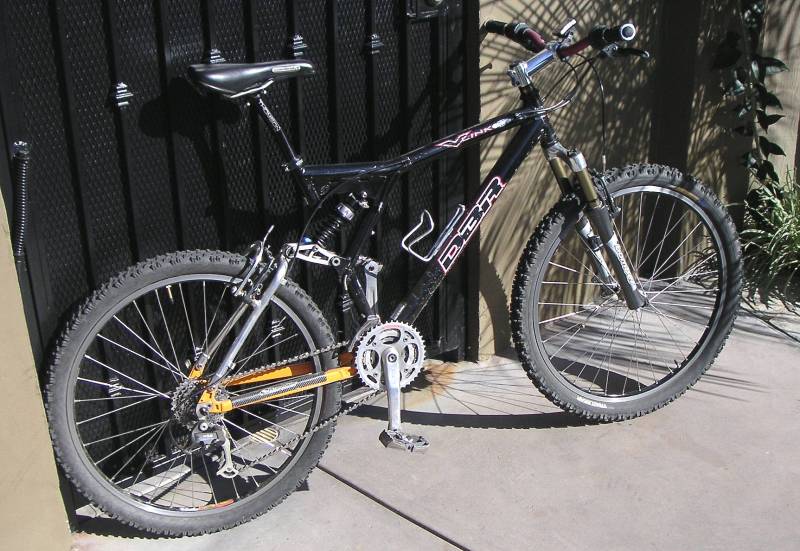
Sorry for any missing pictures. Due to relocation, one of my storage sites was shut down. I'll SLOWLY be moving all images to the ws.geocities serviers to get this fully up and running again.
- DBR portion of Jan. 1998 MBA article on lightweight FS bikes - features the 1998 V8 (page 1, page 2)
- July 1998 MBA article on how to build a 20.5 pound V-Link! (page 1, page 2)
- Jan 1997 Mountain Bike Action (MBA) review of V-Link 3.1 (page 1, page 2)
- Coming soon: Full 1997 Catalog Scans
What are DBR V-Links and other DBR V-Bikes??
Thanks to MTBR, Epinions and some Ebay sellers for the photos. Note that years listed are model years.
Background:
DBR stands for Diamondback Racing and was a name introduced introduced to mountain biking with the 1993 Diamondback Axis and Dual Response models. Axis was a hardtrail and - at different times - available in steel, aluminum and titanium. DBR's carbon fiber hardtails were known as "WCF" (welded carbon fiber) models. Dual Response was an early downhill bike, available 1993 through 1995 - here's a link to one owner's site.
1996: The Diamondback V-Link was introduced. Models included 1.0 ($1,050, green), 3.0 ($1,450, orange) and Pro ($2,499, ball burnished). These appear to have all shared the same aluminum frame. Travel was about 3".
1997: The V-Link was badged as a DBR on the down tube. The carbon fiber V-Link Pro ($3,500, black) was intruduced. The V-Link 1.1 ($1,200, red or black) and 3.1 ($1,600, brushed aluminum) were the other two models available. Travel was about 3".
1998 (click for catalog cover) : DBR revised the V-link frame design and offered serveral more versions:
V-Link 1.2 ($900, White/Ball burnished or Ball burnished/Black) 4.25" rear suspension travel, 28.75 pounds
V-Link 3.2 ($1,100, Red/Ball Burnished or Black/Ball burnished) 4.25" rear travel, 28.5 pounds
V6 ($1,500, Green/Black) trailbike/aggressive XC, aluminum frame, 4.25" rear travel, 28.5 pounds (click for catalog pg. 2)
V6 Team ($2,000, Team Yellow/black frame) XC race bike, carbon fiber frame, 3.25" rear travel, 26.5 pounds
V8 ($2,200, Blue/Red) XC race bike, aluminum frame, 3.25" rear travel, 24.75 pounds
V10 ($3,000, Black/Mango) freeride/trailbike, aluminum frame, dual-crown fork, 4.25" rear travel, 29.0 pounds (cat. pg. 2)
Team Issue ($2,500, Team Yellow) Hardtail XC race bike, 22.75 pounds (click for pg. 2)
Notes: Color indicates Main triangle/Rear Triangle. Weights are from the 1998 DBR catalog spec sheet.
1999: DBR dropped the V-Link/V-Bikes and introduced the X- and XR-Bikes:
X-2 ($1,000, "Blackout" or "Fire and Ice") 3.75-4.5" adjustable travel, 31.5 pounds
XR-4 ($1,600, "Mardi Gras"), 3.75-4.5" travel, 26.5 pounds
X-6 ($1,600, "Iceberg" or "Ultra Voilet") freeride/downhill, 4.25-5" travel, 31.0 pounds
XR-8 ($2,500, "World Cup") XC race, 3.75-4.5" travel, 25.0 pounds
X-10 ($2,900, "Metallic Green Envy") freeride/downhill, 4.25-5" travel, 31.0 pounds
The X-2, XR-4 and XR-8 shared a frame, while the X-6 and X-10 had a beefier, truly freeride and downhill capable frame that naturally weighed more. All of the X- and XR-bikes offered two suspension travel settings (known as dual duty).
2000: Diamondback offered the following, with no bikes badged "DBR" on their downtubes:
X-Link ($875 , "Black/Black" or "Catus/Black"), 5.0" travel
XR-1 ($1,450 , "Monochrome White with Black Stays and Fork"), 5.0" travel
X-2 ($1,200, "2AM Black with California Stays and Fork"), 5.0" travel
X-6 ($1 650, Mechanical Grey with Black Stays and Fork"), 5.0" travel
XR-8 ($2,150, "Team Yellow with Black Stays and Fork" - photos show red stays/fork(?)), 5.0" travel (rear)
Spec levels went down for 2000. These bikes appear to have the "dual duty" links, but I can't verify adjustable travel.
2001: The new XSL series XC bikes looked somewhat like the old V-Links/V-Bikes and the XTS freeride/downhill bikes looked remarkably like 1999 and 2000 X/XR-Bikes. These two product lines remain in production to date.
2004: The DBR name was re-introduced on certain DB bikes, but was not the primary downtube badge.
2006: DBR was reintroduced to the downtubes of the new Strike downhill and Axis hardtail XC bikes. This was the end of DBR mountain bikes and only DB's road bikes are badged DBR now.
Comments on V-bikes: "Long travel" V-Link or V-bikes have travel (4.25-inches) comparable to XC-oriented frames sold today. With lockouts, the V-Link is a great climber. Without a rear lockout (or on my V6, which didn't have one), there was quite a bit of bob on extended climbs. For rolling hills, though, I never used (nor missed) lockouts. Properly maintained and set up, these are high quality, high performance bikes and you won't see many of them on the trails these days.
Buying Considerations:
1) Note to likers of Bling or serious mud/wet riders - There is no disc brake mount on the V-Link/V-Bike frame. I have read that the A2Z disc adaptor will fit with some modifications, but I don't have details nor any direct experience.
2) The seat post is interrupted and has a relatively small range of adjustmant. My recommendation (assuming you have the right size frame) is to get a 250mm post and cut so the max height you need is at the minimum frame insertion point. This way, you can drop the seat the maximum amount without losing your best pedaling position.
3) Watch for cracks (click for more info)! I've had friendly Ebayers send good, close-up photos.
A NOTE ON X-Bikes: These bikes have a rear disc brake mount, BUT the mount is located inside the rear triangle, unlike typical mounts. This means not all rear disc setups will work. One owner emailed me to say he was able to mount a Hope Mini std. front caliper for the rear and used a 165mm rotor with no trouble. Normally one would use a 145mm rotor with this caliper, but the XR frame dictated the 165mm. Thanks, Tony, for the info. I hope this helps...
